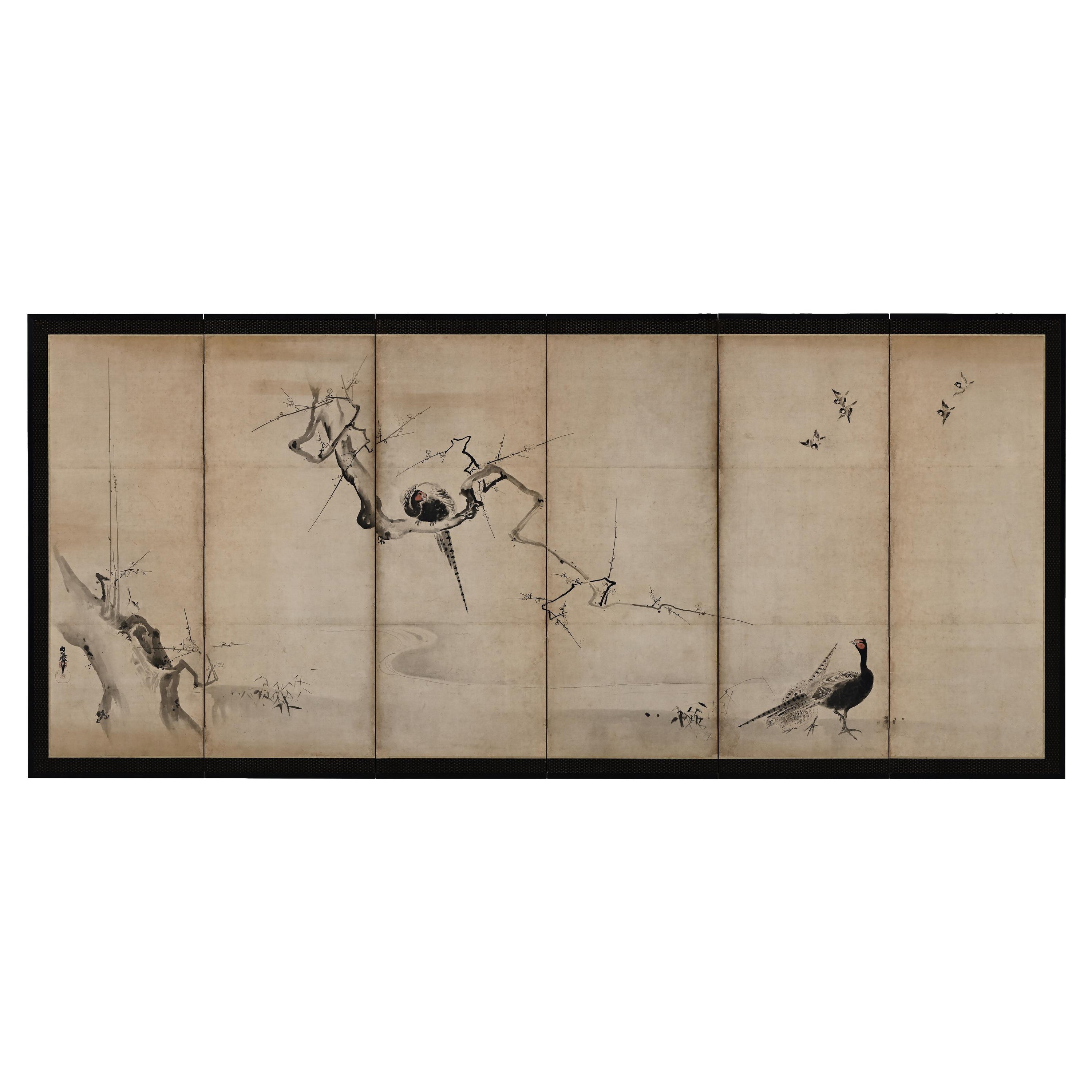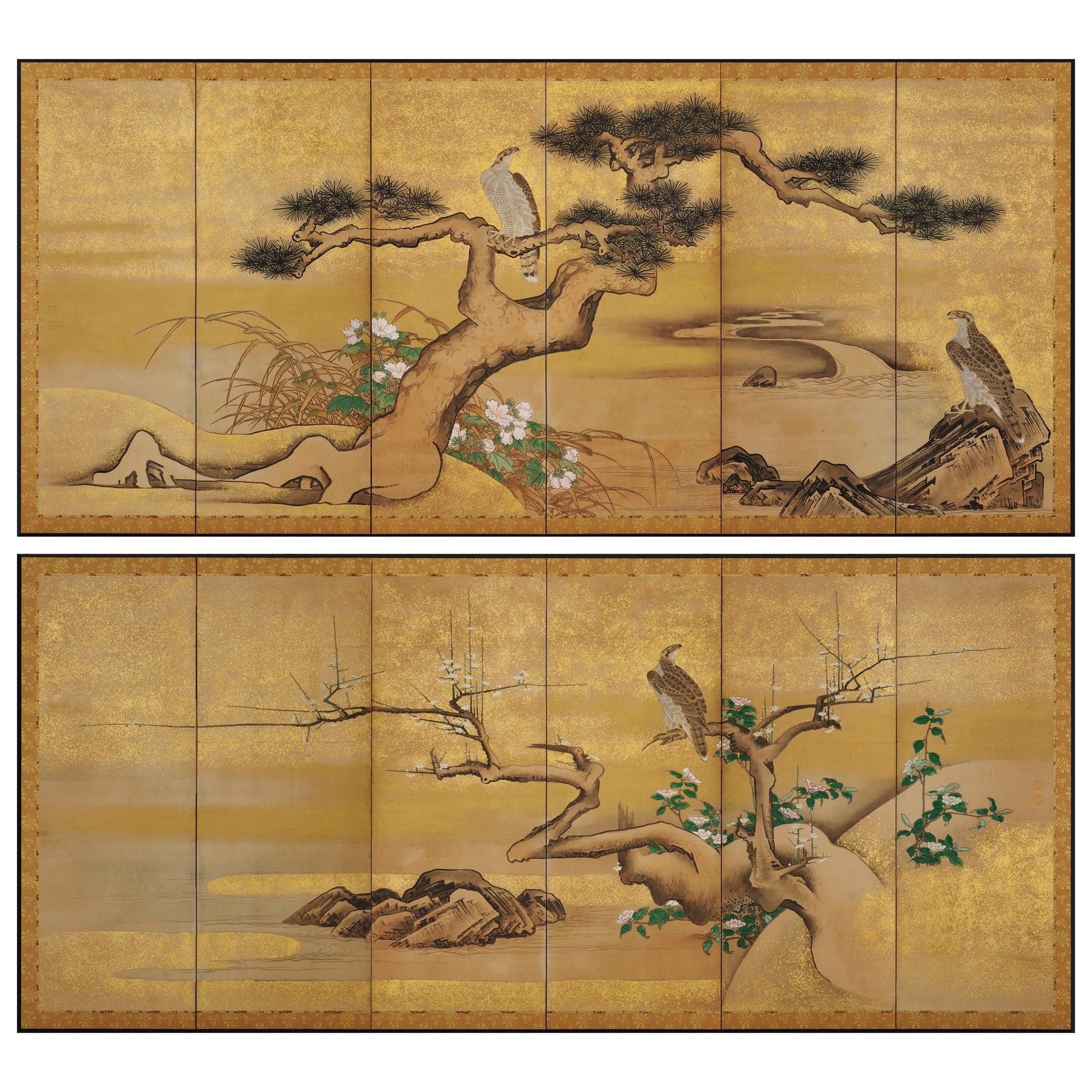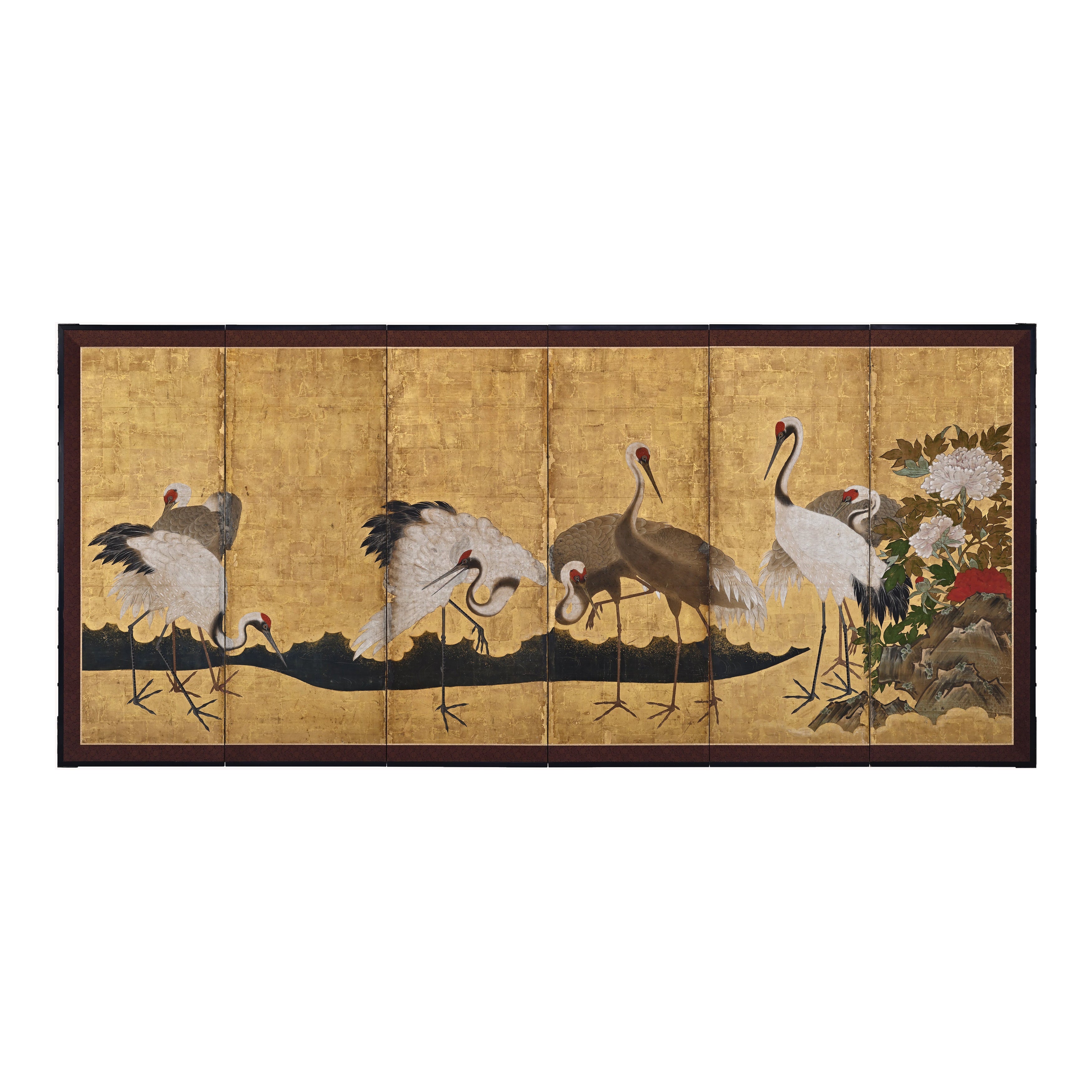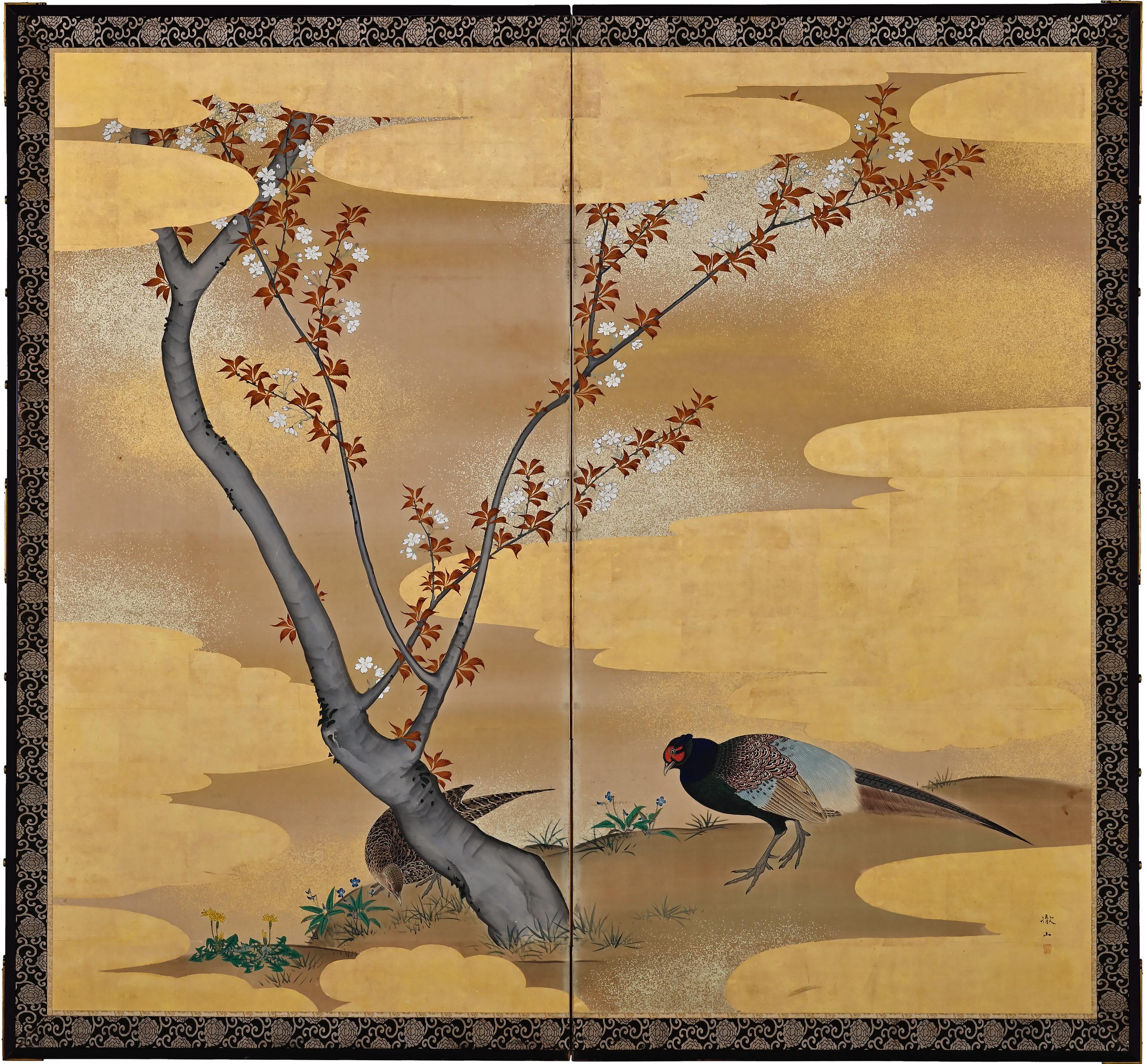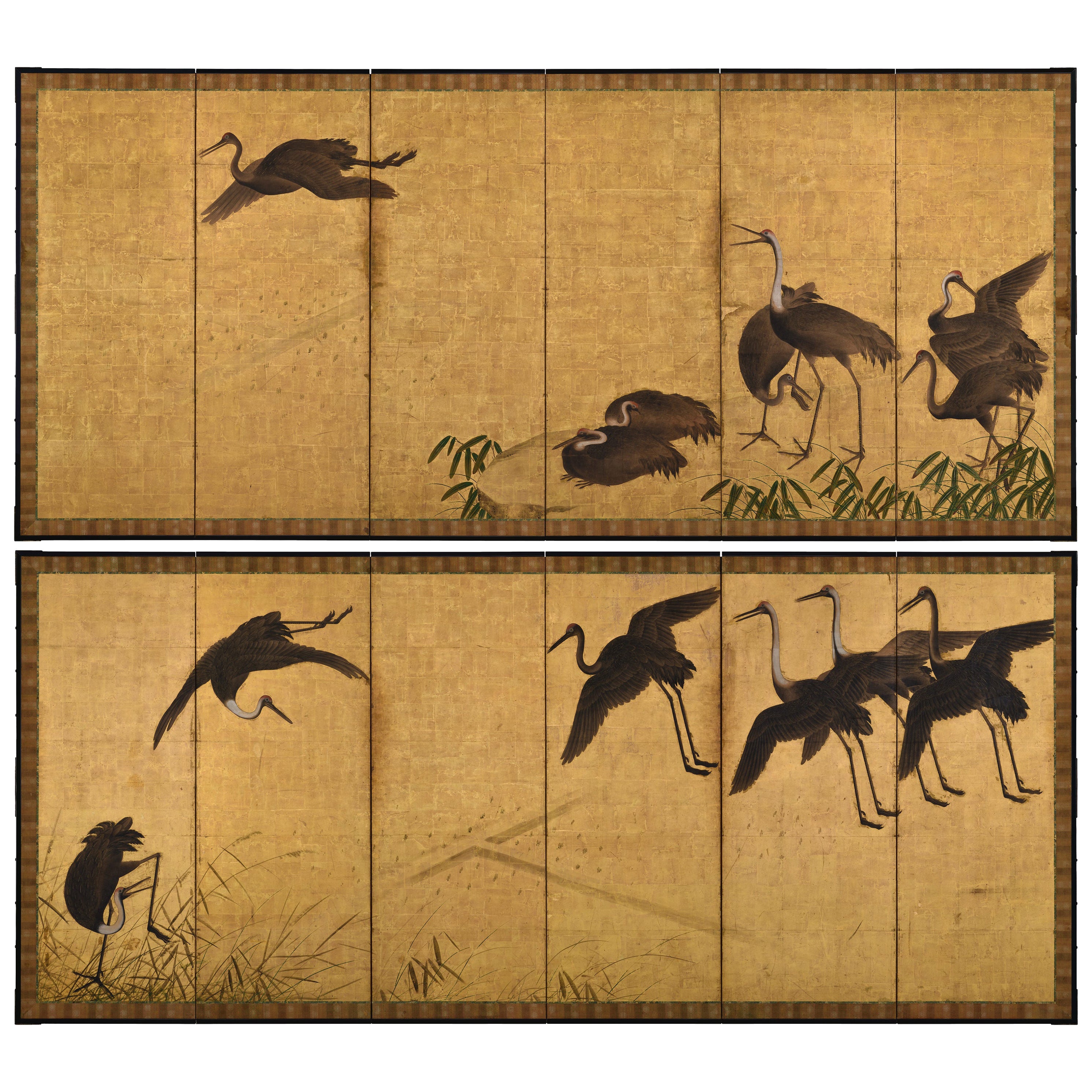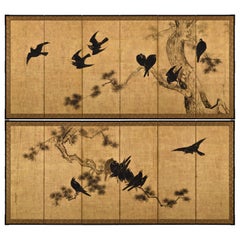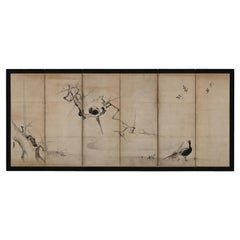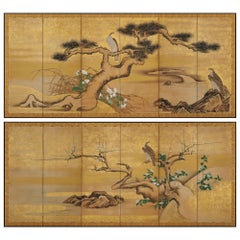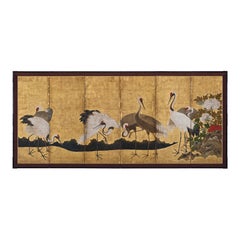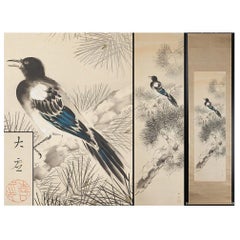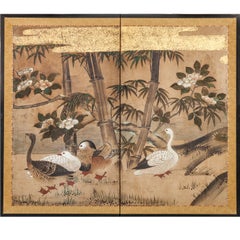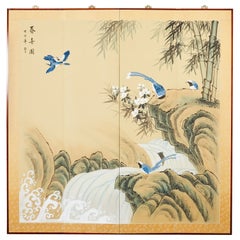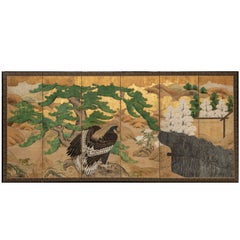Items Similar to Momoyama period Japanese Screen. Crows on Pine. Studio of Hasegawa Tohaku.
Want more images or videos?
Request additional images or videos from the seller
1 of 9
Momoyama period Japanese Screen. Crows on Pine. Studio of Hasegawa Tohaku.
$85,000
£64,542.51
€73,809.18
CA$118,757.33
A$132,084.07
CHF 68,970.20
MX$1,607,322.63
NOK 880,854.66
SEK 826,086.27
DKK 550,866.22
Shipping
Retrieving quote...The 1stDibs Promise:
Authenticity Guarantee,
Money-Back Guarantee,
24-Hour Cancellation
About the Item
Studio of Hasegawa Tohaku (1539-1610)
“Crows on Pine”
Momoyama period. Early 17th Century.
A six-panel Japanese Screen. Ink on paper.
The early 17th century Momoyama period screen “Crows on Pine” is a recent discovery. Although it has no signature or seal, it is obviously closely related to the right-side screen of “Crows on Pine and White Herons on Willow," by Hasegawa Tohaku (1539-1610). Held in the Idemitsu Museum of Arts, Tokyo it is one of Tohaku’s representative pieces. Both works feature a family of crows in a pine tree. The newly discovered screen is more strongly focused on the central tree and the birds and the artist has placed more emphasis on the pine needles. The brushwork is more dynamic and the denser ink-strokes create stronger contrasts. In the Tohaku screen in the Idemitsu museum the brushwork is gentler and more atmospheric. The chicks are more integrated into the nest with a softer visual presence. The composition has more emphasis on negative space and narrative flow. Hasegawa Tōhaku painted “Crows on Pine and White Herons on Willow" in the late 16th century.
Another work by Tohaku with strong stylistic similarities to the present screen is “Old Trees and Monkeys”, an Important Cultural Property presently held in the Kyoto National Museum. Due to its dynamic brushwork and thickly applied ink it is thought to date from latter part of the artist’s career, post 1600. “Crows and Herons” is an Important Cultural Property painted by Tohaku previously held in the Kawamura Memorial DIC Museum of Art. The painting was created after 1605. It is a representative work from Tōhaku's later years and demonstrates denser composition, stronger brushwork and thicker, more highly contrasting ink-work.
The recently discovered “Crows on Pine” is thought to date to the late period of Tohaku’s life. Not the work of the master himself, but painted by one of his son’s or disciples likely working under the master’s supervision. For a directly relatable work from the Hasegawa school in the late Momoyama period see: ‘Pine Trees in Moonlight’, attributed to Hasegawa Tohaku. This pair of screens was widely exhibited and published within Japan and eventually sold through Christies New York in 2007.
Hasegawa Tohaku (1539-1610) had four sons, Kyuzou, Sotaku, Sakon, and Soya, but Kyuzou, who was the most gifted of them all, died at the early age of 26, and Sotaku temporarily inherited the family lineage but died the year after Tohaku 's death . In the end, his third son, Sakon, took over the school. Other artists in the Hasegawa school during Tohaku's active period included Tohaku's pupil and son-in-law Tohaku Toin, who went to Edo and produced screen paintings for Katori Shrine and the Date clan's Zuigan-ji Temple , as well as Toho, Toji, Tojin, Toen, and others. The screen paintings at Chishaku-in (formerly Shoun-ji Temple), Sanbo-in, Myoren-ji, and Zenrin-ji Temple are thought to be works of the Hasegawa school.
- Dimensions:Height: 66 in (167.64 cm)Width: 141 in (358.14 cm)Depth: 0.75 in (1.91 cm)
- Style:Medieval (Of the Period)
- Materials and Techniques:
- Place of Origin:
- Period:Early 17th Century
- Date of Manufacture:Circa 1605
- Condition:Repaired: The screen has been beautifully restored and presented to a very high level. Paper replacements and re-touching have occurred at various stages throughout its long life. Please contact me for a more detailed conditional report. Refinished. Minor losses.
- Seller Location:Kyoto, JP
- Reference Number:1stDibs: LU2472345369112
About the Seller
5.0
Recognized Seller
These prestigious sellers are industry leaders and represent the highest echelon for item quality and design.
Established in 2001
1stDibs seller since 2016
70 sales on 1stDibs
Typical response time: 6 hours
- ShippingRetrieving quote...Shipping from: Kyoto, Japan
- Return Policy
Authenticity Guarantee
In the unlikely event there’s an issue with an item’s authenticity, contact us within 1 year for a full refund. DetailsMoney-Back Guarantee
If your item is not as described, is damaged in transit, or does not arrive, contact us within 7 days for a full refund. Details24-Hour Cancellation
You have a 24-hour grace period in which to reconsider your purchase, with no questions asked.Vetted Professional Sellers
Our world-class sellers must adhere to strict standards for service and quality, maintaining the integrity of our listings.Price-Match Guarantee
If you find that a seller listed the same item for a lower price elsewhere, we’ll match it.Trusted Global Delivery
Our best-in-class carrier network provides specialized shipping options worldwide, including custom delivery.More From This Seller
View AllMid 18th Century Japanese Screen Pair. Crows & Pines by Unkoku Toshuku.
Located in Kyoto, JP
Unkoku Toshuku (1722-1779)
Crows and Pines
A pair of six-panel Japanese Screens. Ink and gold leaf on paper.
Dimensions: Each Screen: H. 170.5 cm x W. 375 cm
Haha-cho or mynah birds, whose forms resemble crows in artwork, were commonly depicted in Japanese art. These types of paintings were originally modeled on paintings attributed to the 13th century Chinese painter Muqi (Mokkei), whose art was enormously influential in Japan. Crows only became a theme among Japanese artists from the later 1500s onward. They likely were inspired by these imported Chinese paintings of myna birds, which are not native to Japan, substituting the native species of crow instead.
The best known early examples of the depiction of Japanese crows are two Momoyama screen...
Category
Antique Mid-18th Century Japanese Edo Paintings and Screens
Materials
Gold Leaf
17th Century Japanese Screen. Ink Plum Tree & Birds by Kano Naonobu.
Located in Kyoto, JP
Kano Naonobu (1607-1650)
Plum Tree and Birds
Six-fold Japanese Screen. Ink and slight color on paper.
In this evocative ink work spread over a six-panel folding screen, we see the consummation of the elegance and refinement of the Edo Kano school. This 17th century screen is a rare surviving example of a large-scale bird and flower painting by Kano Naonobu, the younger brother of Kano Tanyu...
Category
Antique 17th Century Japanese Edo Paintings and Screens
Materials
Wood, Paper
17th Century Japanese Screen Pair by Soga Nichokuan, Hawks on Pine & Plum Trees
Located in Kyoto, JP
Hawks on plum and pine
Soga Nichokuan (active circa 1625-1660)
Pair of six-fold screens.
Ink, mineral pigments, gofun, gold and speckled gold l...
Category
Antique 1640s Japanese Edo Paintings and Screens
Materials
Wood, Paper
17th Century Japanese Screen. Cranes and Peonies. Edo period.
Located in Kyoto, JP
Cranes and Peonies
Anonymous, Kano School.
Edo period, second half of the 17th century.
Six-panel Japanese screen. Ink, pigment gofun and gold leaf on paper.
This Japanese screen...
Category
Antique Mid-17th Century Japanese Edo Paintings and Screens
Materials
Gold Leaf
Early 19th Century Japanese Screen. Cherry Blossom & Pheasants by Mori Tetsuzan
Located in Kyoto, JP
Mori Tetsuzan (1775-1841)
Pheasants and Cherry Blossoms
Two-fold Japanese screen. Ink, color, gofun, gold and silver on paper.
A two-fold Japanese bir...
Category
Antique Early 19th Century Japanese Edo Paintings and Screens
Materials
Gold Leaf
17th Century Japanese Screen Pair. Flock of Cranes. Ink and color on gold leaf.
Located in Kyoto, JP
A pair of six-fold Japanese screens from the 17th century depicting a flock of cranes arriving at their wintering grounds. The expansive scene is heavily atmospheric. The cranes are...
Category
Antique 17th Century Japanese Edo Paintings and Screens
Materials
Gold Leaf
You May Also Like
Magpie Nihonga Scene Meiji/Taisho Period Scroll Japan Artist Meiji Period
Located in Amsterdam, Noord Holland
Axis: Vertical 194 cm, horizontal 49.5 cm
Inside: Vertical 126 cm, horizontal 37 cm some errors will occur in the dimensions. Please understand.
Status I don't know the details of ...
Category
Antique 19th Century Japanese Meiji Paintings and Screens
Materials
Silk
$814 Sale Price
20% Off
Japanese Two Panel Screen: Mandarin Ducks and Geese Among Bamboo and Flowers
Located in Hudson, NY
Japanese Two Panel Screen: Mandarin Ducks and Geese Among Bamboo and Flowers, Edo period painting (c. 1850) of mandarin ducks and geese on a grassy sh...
Category
Antique Mid-19th Century Japanese Edo Paintings and Screens
Materials
Gold
Japanese Style Four Panel Screen Bamboo Waterfall with Magpies
Located in Rio Vista, CA
Large Chinese four panel Japanese style byobu folding screen depicting a waterfall landscape. The scene is decorated with bamboo, colorful blue magpies, and crashing waves. Construct...
Category
20th Century Chinese Showa Paintings and Screens
Materials
Brass
Japanese Six Panel Screen: Hawk with Ancient Pine Overlooking Twig Fence
Located in Hudson, NY
Beautiful and dramatic Kano school painting of a hawk perched on a rock. With flowering cherry, peonies, pine and bamboo. Twig fence on the right is made of heavily oxidized silver...
Category
Antique 18th Century Japanese Paintings and Screens
Materials
Gold Leaf, Silver Leaf
Japanese Two Panel Screen Manchurian Crane and Turtles
Located in Hudson, NY
In Japan, cranes symbolize fidelity as they mate for life and turtles symbolize longevity. Additionally, this screen also has the Japanese motif of sho-chiku-bai, or the three friends of winter (pine, plum, and bamboo). So called the three friends of winter because all three flourish during the cold months. This screen was originally fusuma doors...
Category
Antique Mid-19th Century Japanese Edo Paintings and Screens
Materials
Paper
Antique 19th Century Japanese Two-Panel Screen ‘Byobu’, Kano School, Edo Period
Located in London, GB
Japanese Kano School Edo period two-panel screen depicting flowering prunus and bamboo on a rock formation, with colorful birds next to a body of water. ...
Category
Antique Mid-19th Century Japanese Edo Paintings and Screens
Materials
Gold Leaf
More Ways To Browse
Antique Law
Dior Asia
Christy Brown
Painting Antique Pine Furniture
Medieval Panel
16th Century Japanese
Antique Heron
Antique Furniture Tokyo
Japanese Screen Kyoto
Pair Of Japanese Screens
Painted Panel Screen Birds
Antique Crow
Japanese Antique Shrines
Monkey And Bird
Japanese Monkey
Monkey Japan
Kyoto Screens
17th Century Japanese Paintings

